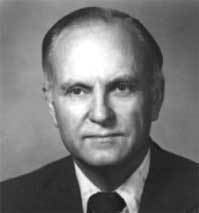Nationality German-American Role Economist Name Hans Sennholz | ||
 | ||
Institution Foundation for Economic Education(1992–1996)Grove City College(1956–1992)Iona College(1954–1955) Alma mater New York University(PhD) 1955University of Cologne(Dr. rer. pol.) 1949University of Marburg(M.A.) 1948University of Texas Books Age of inflation, Money & Freedom, Debts and deficits Education Fields Macroeconomics, Political Science Similar People Ludwig von Mises, Ron Paul, Murray Rothbard, Eugen Bohm von Bawerk, Peter Boettke | ||
Warning about Federal Reserve and Market Bubble in 1997.
Hans F. Sennholz (; [ˈzɛnhɔlts]; 3 February 1922 – 23 June 2007) was a German-born American Austrian School economist and prolific author who studied under Ludwig von Mises. A Luftwaffe pilot during World War II, he was shot down over North Africa on 31 August 1942, and spent the remainder of the war in a POW camp in the United States.
Contents
- Warning about Federal Reserve and Market Bubble in 1997
- Early life
- Post war education and career
- Sennholzs influence
- Books
- Articles
- References

After returning to Germany, Sennholz took degrees at the universities of Marburg in 1948 and Köln in 1949. He then moved to the United States to study for a Ph.D. at New York University where he became Mises' first PhD student in the United States. He taught economics at Grove City College, 1956–1992. After he retired, he became president of the Foundation for Economic Education, 1992–1997.
Joseph Salerno and Joseph Schumpeter have both praised Sennholz for his exceptional prose clarity in defense of the Austrian school.
Early life
Hans F. Sennholz was a German-born American Austrian School economist who studied under Ludwig von Mises. He was drafted into the Luftwaffe during World War II and became the pilot of a Messerschmitt Bf-109, earning the Iron Cross for valor from his engagements in Norway, France, and Russia. He was shot down over North Africa on August 31, 1942, at a time when the battle for north Africa was intensifying, and spent the remainder of the war in a POW camp in the United States, ultimately located to a POW camp in Wilson, Arkansas, where he worked from 1945 to 1946 at the Wilson dairy farm "milking 20 cows twice a day".
During his stay in Arkansas, he maintained a journal of his time as a POW prisoner. When he was transferred back to Germany in 1946, he gave the journal to a trusted guard. "Please send this to my home when the time comes." But the journal never arrived.
In 1964, William Harrison, a factory worker in Jonesboro, Arkansas, found the journal along the banks of Bay Ditch, a drainage artery bordering 'old' Highway 63, and kept it. In November, 1985, Harrison took the journal to Scott Darwin, a professor of German at Arkansas State University. Darwin informed Harrison that no one on staff could read it because it had been hand written in a script of German that was no longer used. The journal was eventually translated by Erika Cohen, the German-born wife of Robert S. Cohen, M.D., whom she married while he was serving in the U.S. Army Medical Corps. Having attended school in the 1930s, she was able to read the script.
The journal told the story of its author's life as a Luftwaffe pilot, being shot down in north Africa and his subsequent time as a German POW in Arkansas. There was no indication as to the identity of the author. This, perhaps, was intentional, as POWs were not supposed to have personal possessions.
In 1988, Harrison published the story, "Who Wrote the Diary", in Die Welt, a large-circulation German newspaper. Willie Weischhoff read the story, which mentioned him by name, and wrote to his friend and fellow German POW, Hans Sennholz, a Professor of Economics at Grove City College. On October 20, 1988, Harrison received a letter from Sennholz stating: "I am the POW author you have been looking for."
Post-war education and career
After returning to Germany, Sennholz took degrees at the universities of Marburg in 1948 and Köln in 1949. He then moved to the United States to study for a Ph.D. at New York University. He was Ludwig von Mises' first PhD student in the United States. He taught economics at Grove City College, 1956–1992, having been hired as department chair upon arrival. After he retired, he became president of the Foundation for Economic Education, 1992–1997. Calvinist Political Philosopher, John W. Robbins, pointed out in a book printed in honor of Sennholz shortly after his death that "Sennholz, ... rests his defense of a free society on revelation."
Fellow Austrian School economist, Joseph Salerno, praised Sennholz as an under-appreciated member of the Austrian School who "writes so clearly on such a broad range of topics that he is in danger of suffering the same fate as Say and Bastiat. As Joseph Schumpeter pointed out, these two brilliant nineteenth-century French economists, who were also masters of economic rhetoric, wrote with such clarity and style that their work was misjudged by their British inferiors as 'shallow' and 'superficial'."
Sennholz's influence
2008 U.S. presidential candidate, Ron Paul, credits his interest in economics to meeting Sennholz and getting to know him well. Peter Boettke, Deputy Director of the James M. Buchanan Center for Political Economy at George Mason University, first learned economics from Sennholz as a student at Grove City College. Terree P. Wasley Summer, author of the book "What Has Government Done To Our Health Care?" was also heavily influenced by Dr. Hans Sennholz as a student at Grove City College. Lawrence Reed, co-founder of the Mackinac Center for Public Policy in Michigan and current president of the Foundation for Economic Education (FEE), is one of Sennholz's most-accomplished students.
